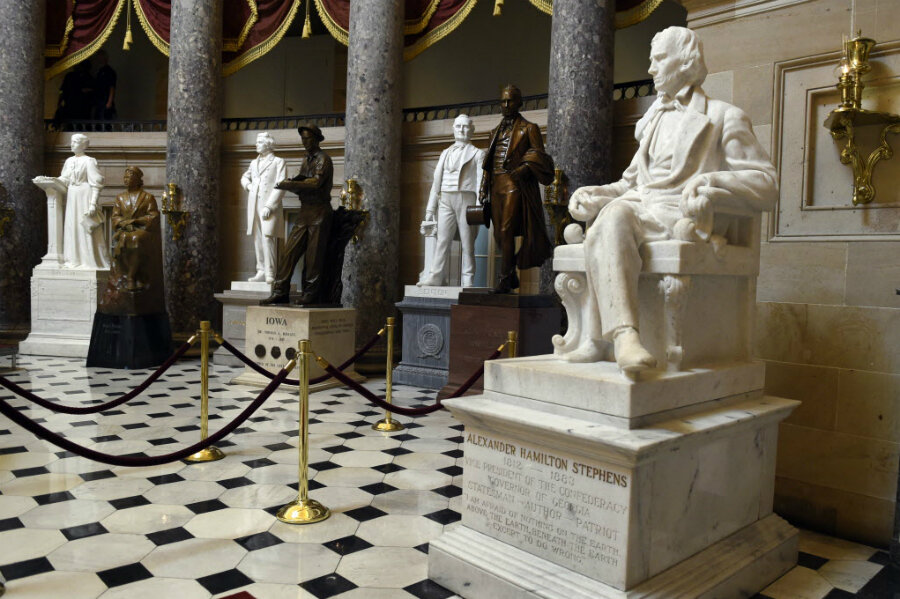If Congress removes Confederate statues, who next: Jefferson?
| Atlanta
As America seeks answers to a senseless massacre of nine black churchgoers in Charleston, S.C., last week by an avowed white supremacist, Confederate symbols, statuary, and legends are under siege from Memphis, Tenn., to Atlanta.
But it’s the United States Capitol that has emerged as a crucible for the larger debate, as lawmakers rethink the meaning and value of displaying statues of these Southern icons.
Georgia designated Alexander Hamilton Stephens, the vice president of the Confederacy, as one of the two persons notable in its history to represent the state in the halls of Congress, for example. Virginia picked Gen. Robert E. Lee, the iconic military hero of the Confederacy.
But as Confederate iconography comes under attack, a difficult question is arising: How far should a national housecleaning go, given that Washington is awash in Confederate remembrances and many Founding Fathers owned slaves.
“The point we’re at [with the debate at the Capitol] is, Do we add to history or do we take away from history?” says Brion McClanahan, a historian and author of “The Politically Incorrect Guide to Real American Heroes.”
“The problem is, if we start taking away Lee, where do you stop?" he adds. "Do you take down the Jefferson Memorial? Do you rename Washington, D.C.?”
Making Congress's statuary representative of an increasingly pluralistic country is a process that has already begun, long before Rep. John Lewis (D) of Georgia on Wednesday called for his state to replace the statue of Alexander Stephens.
This has happened before
As speaker of the House, Rep. Nancy Pelosi (D) of California, without fanfare, moved the Lee statue from Statuary Hall to a less prominent site known as the crypt, one floor down. She replaced it with a statue of Rosa Parks. In 2009, Alabama replaced a statue of Confederate hero Jabez Lamar Monroe Curry with one of Helen Keller.
The Capitol currently houses statues of nine noted Confederates, including secessionists like Wade Hampton and Charles Brantley Aycock, a North Carolinian who ran for governor on a plan to keep schools segregated and who once bragged, “We solved the Negro problem. We have taken him out of politics.”
With the Charleston shootings, the process of challenging symbols of the Confederacy picked up speed nearly overnight, as lawmakers, especially members of the Congressional Black Caucus, called for removing Confederate statues.
Rep. Bennie Thompson (D) of Mississippi also called for his state's flag, the only one to explicitly feature the so-called "Southern Cross" battle flag, to be removed from a Capitol tunnel. On Thursday, the House voted to refer the resolution back to committee – a move often used to postpone measures indefinitely – on a near party-line vote, 240 to 184.
On Wednesday, Congressman Lewis, in an Atlanta Journal-Constitution interview, called the push to remove such symbols "the beginning of a movement that will help us move toward the realization that we're one people, we're one nation, and we have to be sensitive to our history."
Part of the reckoning on Confederate iconography is a growing acknowledgement, especially among conservatives, that long-running African-American complaints about Confederate symbols have validity, given how they can be twisted into murderous action, as the Charleston massacre showed.
Even Southern conservatives have little love for the Confederate battle flag, polls suggest. A 2011 Pew poll showed only 22 percent of whites who identify themselves as Southerners say that they "react positively" when they see a Confederate flag displayed, with a majority reporting they had only neutral (64 percent) or negative (13 percent) feelings toward it.
“This issue of the symbolism of the Confederate flag, how it’s used by hate groups, and in light of the tragedy here in Charleston, is why [taking it down] is something both Republicans and Democrats agree on,” says Gibbs Knotts, a political scientist at the College of Charleston. “And it’s good to see, because there’s so little bipartisanship in the South.”
'Where do you stop?'
But it's not clear how far this purge should go. Some lawmakers on Capitol Hill are already drawing a line between the Confederate battle flag and the statuary, which they say represents important historical figures that, for better or worse, pushed America toward its present iteration.
Confederate statues “are part of our history … and not all of our history is dandelions and butterflies,” Rep. Mick Mulvaney (R) of South Carolina told Fox News.
On Tuesday, Sen. Tim Scott (R) of South Carolina, one of only nine African-Americans ever elected to the Senate and the first since the 1970s, recalled a son of one of the Charleston victims telling him that “this evil attack would lead to reconciliation, restoration, and unity in the nation.”
At the same time, Senator Scott balked at the idea of taking down Confederate statuary from the halls of Congress. So did Rep. Hank Johnson of Georgia, an African-American congressman and a Democrat.
“I think making great progress on ... moving the Confederate battle flag from its place of prominence in so many states, I think that’s a good thing,” he told the Atlanta Journal-Constitution. But "as far as monuments and street names and building names, where do you stop? Where does it all lead to?”
Critics say that such a movement, once begun, will be difficult to rein in.
“What I would call a purge has been going on a long time [regarding] public roads, buildings, curricula,” says Marshall DeRosa, a political scientist at Florida Atlantic University in Boca Raton, Fla., and author of "The Enduring Relevance of Robert E. Lee."
“And it’s not going to stop with Confederate symbols. Next it’ll be symbols that represent the American Revolution, the Founders, anything that has to do with the types of opinions that are [unpopular]."







